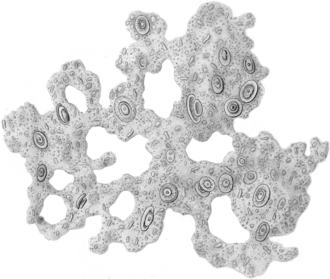Bathybius

Bathybius was a substance discovered in the 19th century in samples from the Atlantic sea floor, which was described by Thomas Henry Huxley in 1868 as a primeval creature. It later turned out that this description had been in error. However, since Bathybius had been assigned a special role in the history of the development of life by some biologists, heated discussions arose which are of interest in the history of science to this day.
In the wake of Darwin's theory of evolution, Ernst Haeckel had taken up Lorenz Oken's theory of the origin of primitive life forms from a kind of “primordial slime”. He postulated the existence of living beings that consisted of only one single substance and thus formed the basis of life. These living things were called Monera . In 1868, the biologist Thomas Henry Huxley examined soil samples from the Atlantic that had been taken ten years earlier when the first transatlantic cable was laid and that had been preserved in alcohol. Huxley found a gelatinous, homogeneous, diffuse mass in which coccoliths were embedded in the samples . Huxley identified this mass as the genus Monera and named it Haeckel in honor of Bathybius Haeckelii . As a result, finds by Bathybius were repeatedly known, including by Charles Wyville Thomson . Haeckel imagined that the entire sea floor was covered with this primordial slime.
During the Challenger expedition with the HMS Challenger from 1872 to 1876, in which Thomson was also involved, attempts were made to find living Bathybius, but unsuccessfully. Bathybius only appeared when specimens were preserved in alcohol. The Challenger researchers finally found that Bathybius was nothing more than colloidally precipitated calcium sulfate . This reaction occurs when alcohol is added.
Huxley accepted this finding and saw his error. Haeckel found it more difficult and held on to the primordial slime even longer. The history of science has dealt more intensively with the Bathybius phenomenon since the 1970s. Today Bathybius is assessed as an understandable error, since it apparently solved several problems: it was the most primitive form of life, the evolutionary precursor for all living beings, the elementary unit of cytology , main component of marine sediments (through the coccoliths, which are now assigned to other living beings) , as well as a food source for higher organisms in the nutrient-poor deep sea . With the loss of the existence of Bathybius all these questions were again unsolved. The Bathybius find inspired extensive research that led to new insights and ultimately to the knowledge of error.
literature
The article is based on:
- Stephen Jay Gould : Bathybius and Eozoon . In: S .J. Gould: The Panda's Thumb . Norton, London 1992, pp. 236-244. ISBN 0-393-30819-7
Further:
- PF Rehbock: Huxley, Haeckel, and the oceanographers: the case of Bathybius haeckelii . In: Isis . Volume 66, 1975, pp. 504-533, PDF .
- NA Rupke: Bathybius Haeckelii and the psychology of scientific discovery . In: Studies in the History an Philosophy of Science . Volume 7, 1976, pp. 53-62, DOI: 10.1016 / 0039-3681 (76) 90003-0 .
Individual evidence
- ^ TH Huxley: On Some Organisms Living at Great Depths in the North Atlaritic Ocean . In: Quarterly Journal of Microscopical Science . New Series, Volume 8, 1868, pp. 203–212, (online) , Plate IV .